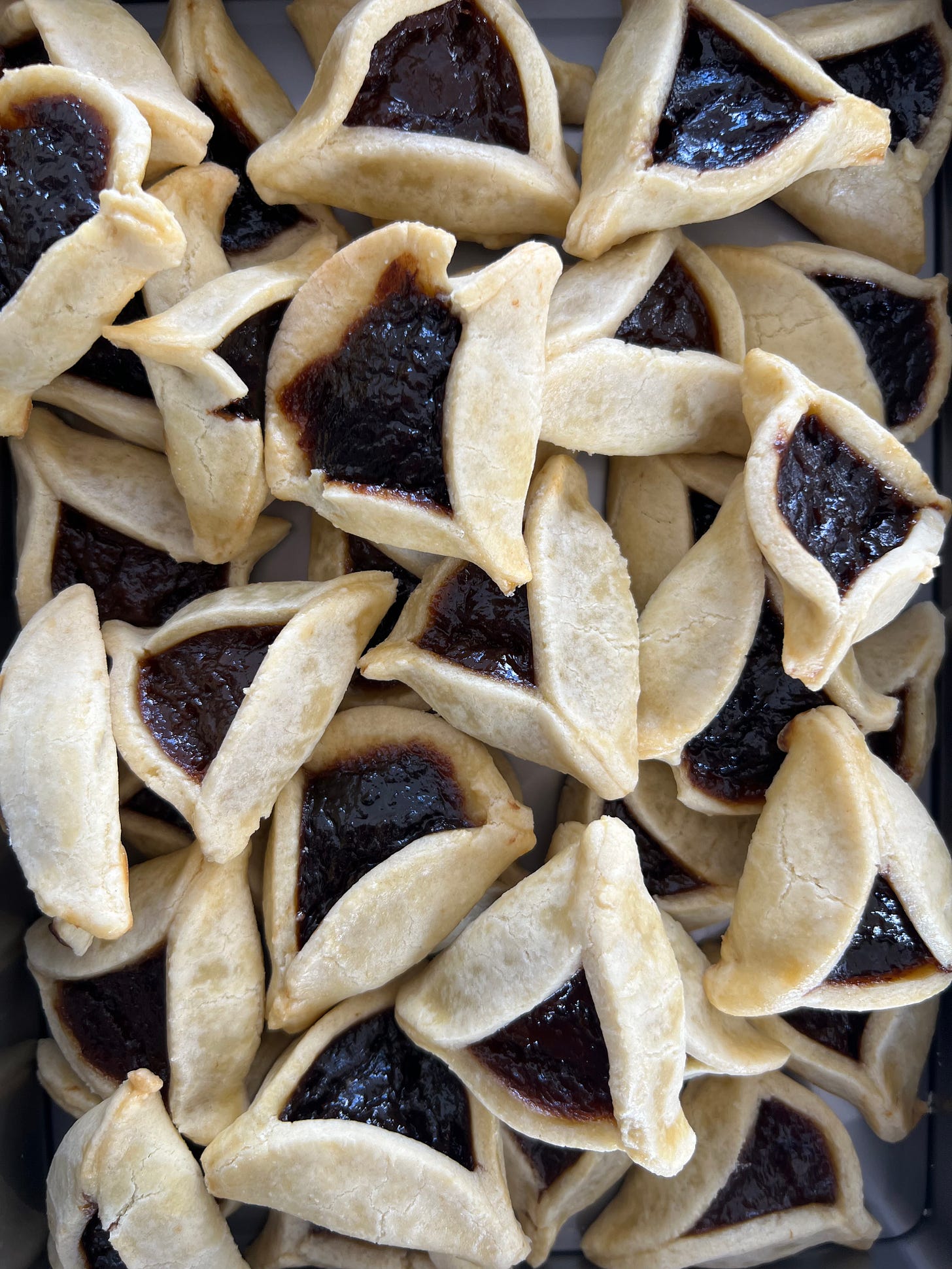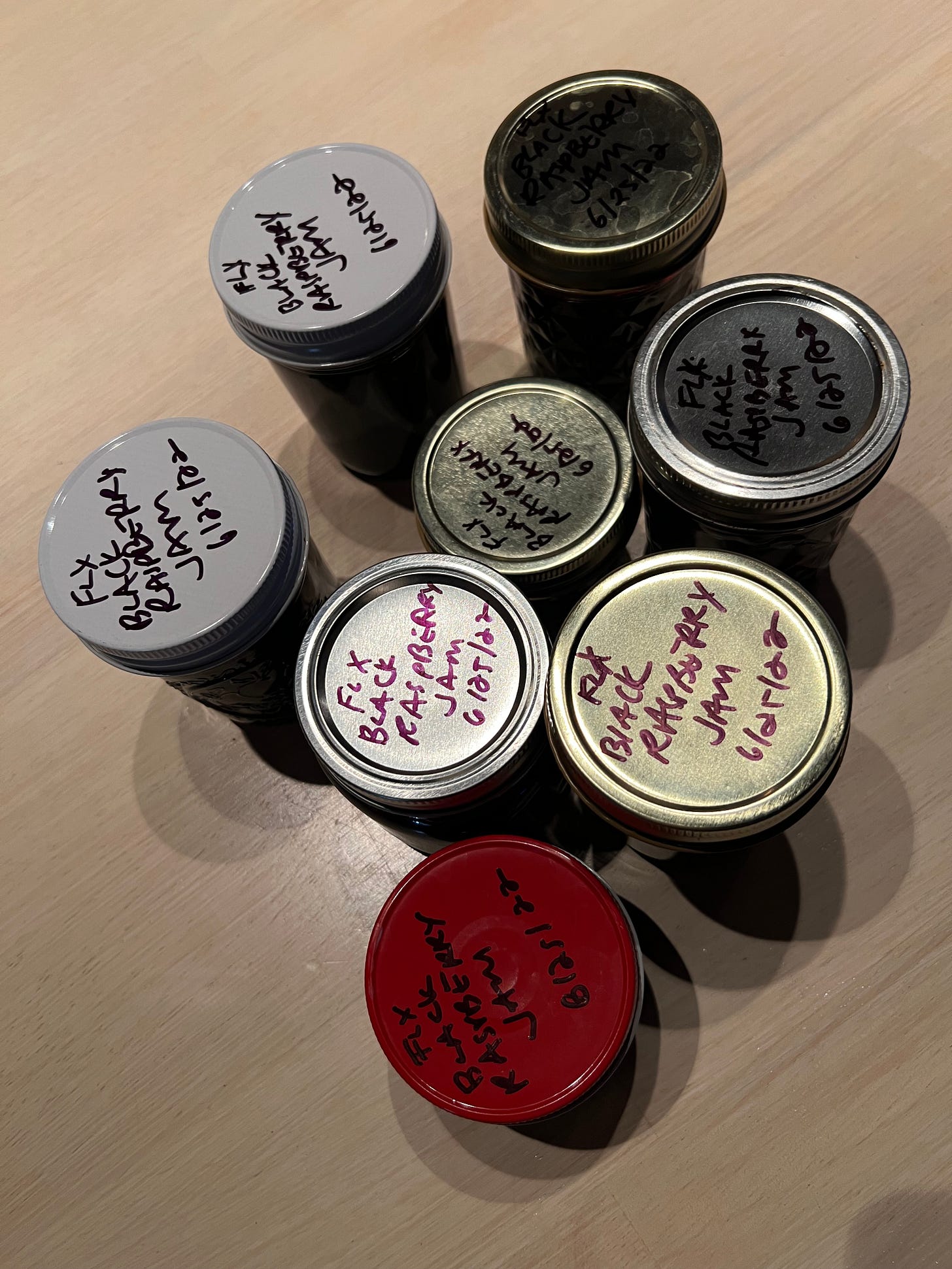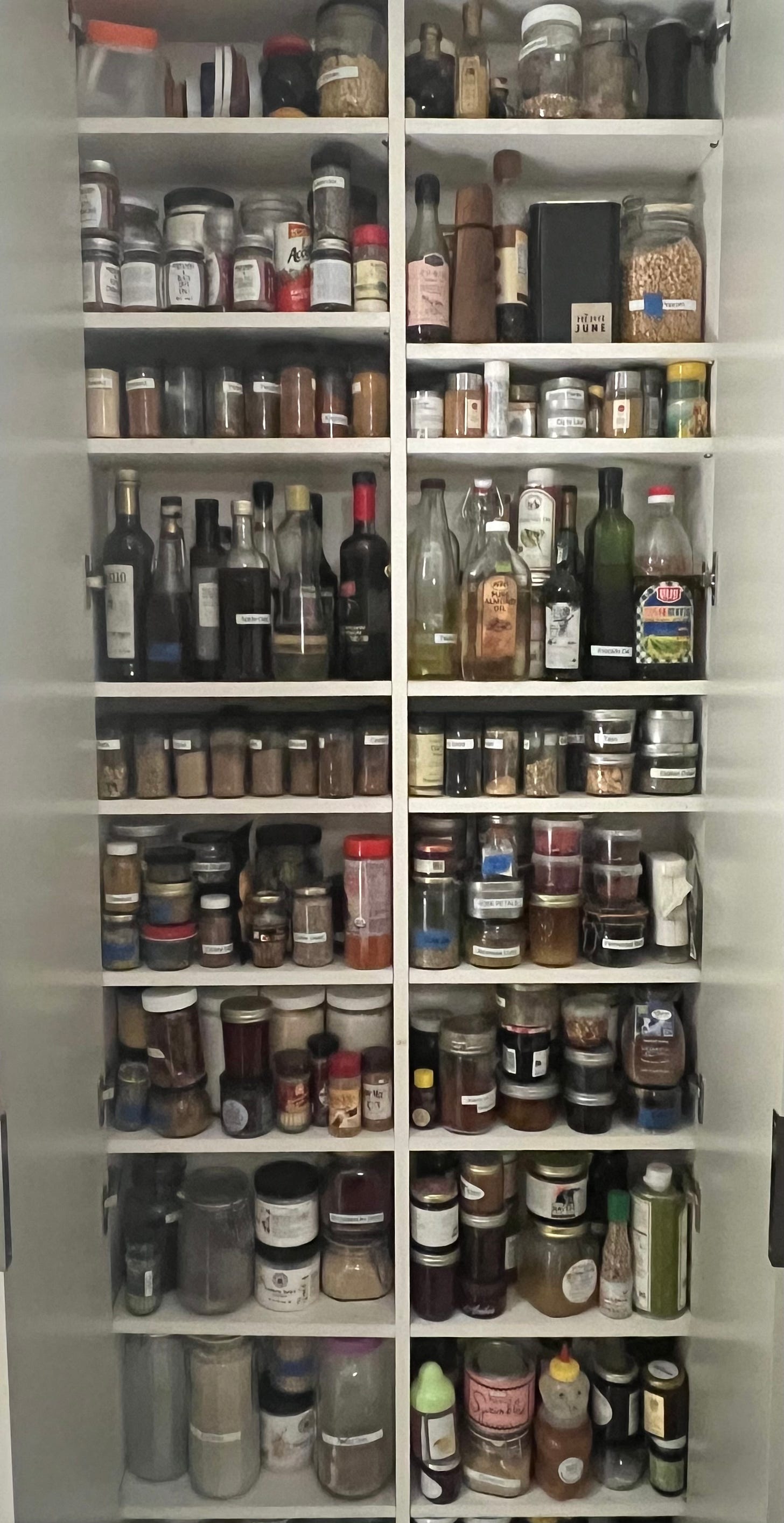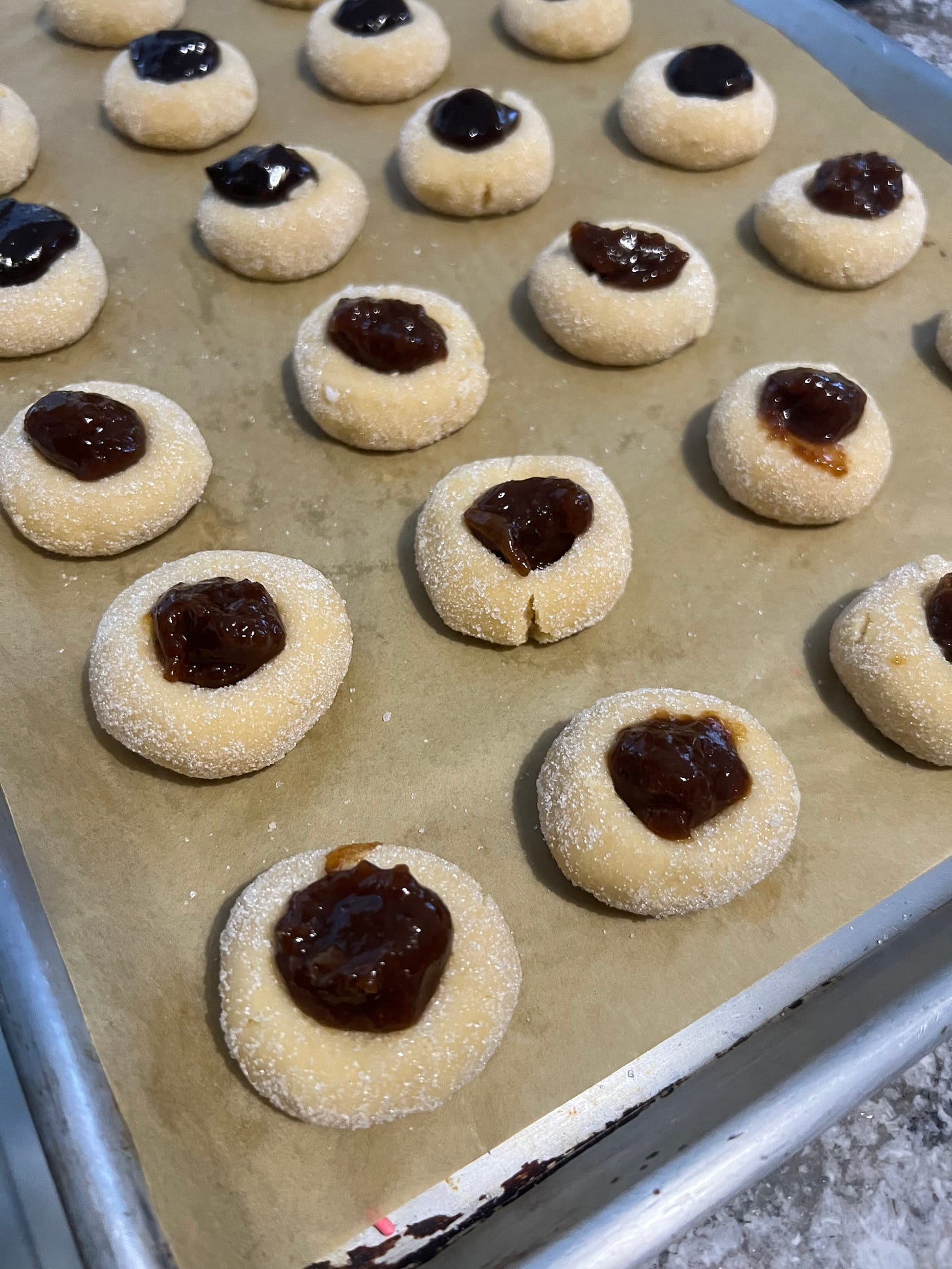Issue #149: Jam Thumbprint Cookies
Excuses and Uses for Excess Jam, Thumprint and Filling Recipes, Scandinavian Surprise
Considering the first issue of this year newsletter almost 150 weeks ago was a recipe for jam (see apricot-vanilla), it should come as no surprise that I identify as a jam maker. Those of us who do are always looking for ways to use up jam. This is because we almost always have a lot of it around—different vintages of raspberry, a couple of flavor combinations only we thought worked well (e.g., blueberry, licorice and Pinot Noir). You get the picture.
As someone known to be a jam maker, you are also, paradoxically, on the receiving end of a lot of jam. Understandably, some friends, usually those who don’t make jam, think a jar of jam from here or there must be a good gift for you, as a jam maker. What they don’t realize is, as I’ve already said, you are actually always looking for ways to use up jam. You certainly are not in need of more.
And sure, if a friend of yours is also a jam maker, you may want to exchange one jar for another, to see what they are up to. But two for one would be better. And you are sensitive that they probably don’t need any more jam, either.
This time of year, the desire to use up what you’ve got in the cupboard increases further as the days turn warm. You can almost sense the fruit budding that you will want to transform into delicious jam one day soon. Vintage 2024 awaits.
What’s more, our recent move revealed deep, dark jam secrets kept if the back corners of cupboards and cabinets. We have more jam than two people can consume on toast.
Favorite Uses for Excess Jam
Which brings me to this week’s topic. In order for me to save a recipe today to use up excess jam tomorrow, it needs to call for more than just a tablespoon or two. You want it to be jam-packed, if you will. Not all of them are winners. I’ve tried many recipes for American jam cakes, which I’m sure are a homestead tradition for the very same reason I am always looking to use up jam. But I’ve never found one I love. The jam makes the batter wet and heavy and usually the cakes, whether loaf or sheet, sink in the middle.
Instead, here are a few of my favorite uses for excess jam:
BBQ Sauce
I know this sounds odd, but you can get a good cup or more of jam into a BBQ sauce instead of sugar or honey or molasses depending on how much you are making. And the flavor undertones of fruit pair nicely with the spices and other flavorings of your sauce. What’s more, a jam-based barbecue sauce creates a beautifully shiny glaze on your barbecued meats.
Granola
Another secret jam use of mine is granola. My granola (see recipe) calls for a considerable amount of honey or maple syrup. Both are delicious, but both are pricy liquid sugar alternatives for which jam makes a good substitute, especially runny jam. Here, too, the fruit adds a delicious flavor note to the finished granola. Most of the orange marmalade we receive—I don’t make marmalade much because Nate doesn’t love it—ends up in granola. I chop it fine before I add it to the wet ingredients.
Fruit Cakes
No, I don’t mean fruitcake fruit cakes. I mean cakes made with fruit. For, while I haven’t found a jam cake (that is, a cake into which jam is stirred into the batter) I love, I do love cakes made with fresh fruit, such as plum crumb cake, apricot cake, cherry cake, fig cake, etc. enhanced with jam of the same kind. I’ll distribute dollops of jam around the fresh fruit to enhance the flavor.
I’ll note here that cakes that are filled with jam, such as Swiss rolls or Victoria sponges are also very good uses of jam.
Cookies
Oaty bar cookies, jam sandwich cookies, Linzer torte (which is really just a giant cookie), hamantaschen, and jam thumbprints are also favorite uses of last year’s or the year before’s jam, too.
It’s the last category that spurred me on to write about this topic today. Over the last couple of weeks, I’ve made a few batches of jam thumbprint cookies, and I can attest that not only are they are a useful tool in the arsenal of waste-not jam consumption, they are also delicious.

In fact, I created this recipe to use up some leftover hamantaschen filling from Purim, which itself was a way to use up jam. I’d been given some fine English apricot and plum preserves that I stirred into my apricot and prune hamantaschen filling, respectively. The results made delicious hamantaschen. And then with the leftover dough (I use Uri Scheft’s almond shortbread dough from his Breaking Breads cookbook) and filling, I made thumbprints—simpler than hamantaschen because they don’t require chilling, rolling, cutting, filling, pinching, and egg-washing.
A few days later I set out expressly to make jam thumbprints. I tweaked the dough, adding flavorings, rolled them into balls, rolled those balls in granulated sugar, and pressed my thumb into them to make space for jam. At this point I froze the thumbprints so I could bake them fresh from the freezer later that week. As proof of the success of this recipe and technique, I offer that I have a dozen thumbprints in the freezer right now ready to fill and bake for friends who are visiting next month.
So, I offer you my new jam thumbprint recipe. A keeper. You can use your jam straight from the jar, or you can use that jam to enrich a filling—the hamantaschen variation. The latter gives the thumbprint filling more density, more heft, and, perhaps, a little more fruit flavor. Either works well. Simple and delicious. #wastenot
RECIPE: Mitchell’s Jam Thumbprint Cookies
Makes 3 ½ dozen cookies
3 cups all-purpose flour
1/2 cup almond flour
2 tablespoons cornstarch
1/2 cup granulated sugar, divided
2 sticks unsalted butter, softened but still cold
1 cup confectioner’s (powdered) sugar
1 large egg
1 large egg yolk
1 teaspoon fine sea salt
1 teaspoon vanilla extract
1/4 teaspoon almond extract
Zest of 1/2 lemon, finely grated (optional)
¾ cup jam or fruit filling (see below)
Line a baking tray that will fit in your fridge or freezer with parchment. Place 1/4 cup of the granulated sugar in a small dish. In a medium mixing bowl, combine the all-purpose flour, almond flour, and cornstarch, and mix with a whisk to blend.
In the bowl of an electric mixer fitted with a paddle, beat together the softened butter, confectioner’s sugar, and the remaining 1/4 cup of granulated sugar until creamed. Scrape down the sides of the bowl as necessary. Add the egg and egg yolk and continue beating until incorporated, scraping down the sides. Add the salt, the vanilla and almond extracts, and the lemon zest, if using, and beat until well mixed. Don’t worry if it looks like the mixture has broken. Add the flour mixture and mix on low speed just until a crumbly dough begins to form. Remove the bowl from the mixer and use a wooden spoon to finish combining the ingredients by hand. (Per Uri, this avoids overmixing.) The dough may still look dry and crumbly, but pinch it together in parts to see that it holds its shape. If not, keep mixing until it does. No powdery patches of flour should remain. Pat the dough into a solid mound in the middle of the bowl.
Pinch off a small golf-ball-sized piece of dough—a heaping tablespoon or so—and roll it between your palms into a ball. Roll this ball in the small dish of granulated sugar to coat and place on the parchment-lined pan. Using your thumb, press a pretty deep indentation into the ball to both flatten the dough into a thick cookie and to create the space to hold the jam filling. A few cracks on the edges of the cookies are fine, but if they seem excessive or unsightly, you can press some back together with your fingers. If you are going to store the cookies before baking, you can pack them rather tightly on the tray. Just don’t let them touch.
At this point you can fill the tray with unfilled cookies, cover with plastic wrap, and either refrigerate them for a couple of days before baking or freeze them until hard and then transfer them to a zipper bag to keep for months. Or you can bake them.
When you are ready to bake, preheat the oven to 375°F. Place the indented cookies about an inch apart on a parchment lined tray. They won’t spread much. Spoon a generous teaspoon of jam or fruit filling in the indentation of each cookie. Place the tray of filled cookies in the preheated oven. Bake for about 15 minutes until set, then lower the temperature to 350°F. and bake another 10 to 15 minutes more until they begin to brown. Remove from the oven and cool for 5 to 10 minutes in the pan before removing to a wire rack to cool completely. Store in an airtight container for 3 or 4 days or freeze for months.
RECIPE: Mitchell’s Jammy Fruit Filling
Makes about 1 1/2 cups
This is a filling I use for hamantaschen and now for thumbprint cookies. You can use either prunes or dried apricots. And then use plum or apricot jam and/or brandies, respectively, to turn up the flavor up a notch.
3/4 cup pitted prunes or dried apricots, diced
1/4 cup golden raisins
2/3 cup water
1 tablespoon plum or apricot brandy (optional)
1/2 teaspoon vanilla, a few drops almond extract, pinch cinnamon, pinch mahleb, or other flavoring (optional)
1/3 cup plum or apricot jam, depending on which fruit you used
In a small saucepan, combine the dried fruit, raisins, and water. Bring to a boil, reduce the heat, and simmer until the fruit is soft, 20 to 30 minutes, depending on how dry the original fruit was. If the water evaporates and the pan dries up, add more water. When soft, use a hand-held emersion blender to purée the filling to a paste. You can make it completely smooth or leave it a little chunky, as you prefer. It should be quite thick. Stir in the brandy and/or flavoring if using and stir in the jam. Chill before using. This filling can be stored in the fridge for a couple of months or frozen indefinitely until needed.
Epilogue: Swedish Synchronicity
So, I was writing this post on a flight on my way to Stockholm for the Big Meet, an annual food tech conference at which I am speaking. I landed, took the train to the center of town, and walked to my hotel, eager to be able to check in so I could finish the newsletter and publish it. Little did I know that they were putting me up at a place called Hotel with Urban Deli, which is really a deli (or food hall and market) with a small hotel attached. You literally walk through a gourmet shop and restaurants to get to the reception. (The video above shows the path.) My kind of place.
As I was checking in, I noticed a jar of giant jam thumbprint cookies on the counter. What are the odds? The receptionist/barista clearly loved these cookies, called Hallongrot, telling me enthusiastically they were a traditional Swedish sweet. These happened to be gluten free, buttery, rich. Now you can make your own.









“We have more jam than two people can consume on toast.”
Gimme a spoon and some bread, and I’ll help you out.